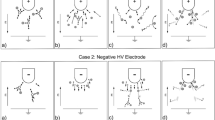Abstract
IF a heavy current is discharged through a very thin wire, the wire disintegrates or ‘explodes’ with a brilliant flash of light. Considerable noise accompanies the flash, a shock wave is emitted, and an expanding cloud of disintegration products is formed. It has been shown that exploding wires may be used for coating glass, etc.1. They may also serve as convenient sources of light of high intensity and short duration2. It was found, by means of photographic photometric reduction in four regions of the spectrum, that a copper wire of 2.5 cm. length and 0.0080 cm. diameter, exploded with 17.5 kV. peak voltage and 1.9 µfd. capacitance, gives a total emission of 6.5 × 108 watts/cm.2. This amount can be increased with increasing voltage and capacitance.
This is a preview of subscription content, access via your institution
Access options
Subscribe to this journal
Receive 51 print issues and online access
$199.00 per year
only $3.90 per issue
Buy this article
- Purchase on Springer Link
- Instant access to full article PDF
Prices may be subject to local taxes which are calculated during checkout
Similar content being viewed by others
References
Conn, W. M., Phys. Rev., 79, 213 (1950).
Conn, W. M., J. Opt. Soc. Amer., 41, 445 (1951).
Kramer, J., Z. Phys., 128, 538 (1950); 129, 34 (1951).
Author information
Authors and Affiliations
Rights and permissions
About this article
Cite this article
CONN, W. A New Effect Observed in Connexion with Electrically ‘Exploded’ Wires. Nature 169, 150–151 (1952). https://doi.org/10.1038/169150b0
Issue Date:
DOI: https://doi.org/10.1038/169150b0
This article is cited by
-
Studies of the mechanism of electrically ?exploded? wires
Die Naturwissenschaften (1955)
-
Decay of Light to Very Low Levels from Spark Discharges
Nature (1952)
Comments
By submitting a comment you agree to abide by our Terms and Community Guidelines. If you find something abusive or that does not comply with our terms or guidelines please flag it as inappropriate.



